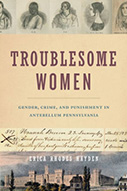Troublesome Women: Gender, Crime, And Punishment In Antebellum Pennsylvania

Author: Erica Rhodes Hayden
Publisher: University Park, PA: The Penn State University Press, 2019. 256p.
Reviewer: Kevin Cassidy | February 2021
This 242-page book by Erica Rhodes Hayden focuses on the experiences of women lawbreakers in the state of Pennsylvania from 1820 to 1860. She painstakingly researched the records of more than six thousand criminal court cases during that time period. In the mid-1800s, Pennsylvania was the second most populous state in America, behind New York. Pennsylvania, like many other states, experienced swift financial, political, and social changes during these years, including changes in crime and criminal justice.
Hayden follows various women from the beginning of their crimes, and takes us through the state’s exertions to punish and reform them. She writes in the introduction, “[a]t the heart of this book is an examination of antebellum female criminality and punishment in Pennsylvania in order to reconstruct the lived experiences of female criminals by analyzing their offences, court experiences, and subsequent treatment as prisoners.” Hayden notes that women in fact constituted just a small percentage of those tried in courtrooms and sentenced to prison terms during the nineteenth century.
Between 1820 and 1860, more and more of America’s manufacturing shifted to mills and factories. Machines took over many of the production tasks, and employment was geared towards men. How did women survive? Some turned to criminal activities. Areas such as crime and punishment and social reform, as well as race, class, and gender, played an integral part in these women’s crimes, punishment and reform. The disparities discussed illustrate clearly how society treated men and women criminals quite differently.
In the beginning of the book, Hayden displays an area map of Pennsylvania during the period 1820 to 1860. This provides the reader with a visual sense of how Pennsylvania looked at the time. The author breaks her book into two main parts. In part one, she discusses the crimes committed by various women. In part two, she discusses their lives as prisoners and the general lack of reform. The two parts are effectively written. Various cases are highlighted, thus providing insight into policing, incarceration, and the absence of treatment and rehabilitation during that time.
Hayden writes of the work of various female reformers such as Dorethea Dix, Mary Waln Wistar and Elizabeth Fry. Fry was the most famous of the Quaker reformers, being influential in raising public awareness. Fry brought to light such reforms as the separation of women and children from men, and the development of rehabilitation and education during incarceration. Her work in Newgate prison in London, England, helped raise public awareness of the atrocities being committed against women in prison.
Erica Hayden explains how these various female prison reformers worked tirelessly to fix issues in the prisons, and to give female inmates a voice to speak out on issues such as they had never had before. Overall, readers from academia, as well as students and practitioners of corrections and prison reform, should find this book to be an enlightening and fascinating read.
Kevin Cassidy-Professor in the Security, Fire & Emergency Management Department at John Jay College. He also lectures at Slippery Rock University in Pennsylvania. He is a member of ASIS, NLEA and ALDONYS.


